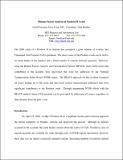| dc.contributor.author | Carrigan, Geoff | |
| dc.contributor.author | Long, Dave | |
| dc.contributor.author | Cummings, M.L. | |
| dc.contributor.author | Duffner, John | |
| dc.date.accessioned | 2014-01-22T16:57:12Z | |
| dc.date.available | 2014-01-22T16:57:12Z | |
| dc.date.issued | 2008-06-10 | |
| dc.identifier.uri | http://hdl.handle.net/1721.1/84129 | |
| dc.description.abstract | The 2006 crash of a Predator B in Arizona has prompted a great amount of scrutiny into Unmanned Arial System (UAS) operations. The direct cause of the Predator crash can be tied to an initial failure of the displays and a failed transfer of controls between operators. However, using the Human Factors Analysis and Classification System (HFACS), many latent errors that contributed to the accident were uncovered that were not addressed by the National Transportation Safety Board (NTSB) report. The HFACS approach for this accident examined all issues leading up to the crash and uncovered several organizational influences that were significant contributors to the Predator crash. Through augmenting NTSB efforts with the HFACS method, future UAS incidents can be prevented by addressing all causes, regardless of their distance from the pilot’s seat. | en_US |
| dc.rights | Attribution-NonCommercial-ShareAlike 3.0 United States | * |
| dc.rights.uri | http://creativecommons.org/licenses/by-nc-sa/3.0/us/ | * |
| dc.subject | Predator B | en_US |
| dc.subject | unmanned arial system (UAS) | en_US |
| dc.subject | human factors analysis and classification system (HFACS) | en_US |
| dc.title | Human Factors Analysis of Predator B Crash | en_US |
| dc.type | Presentation | en_US |
| dc.type | Technical Report | en_US |
